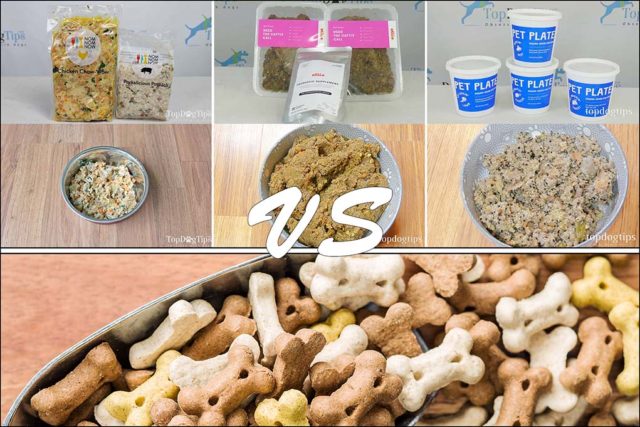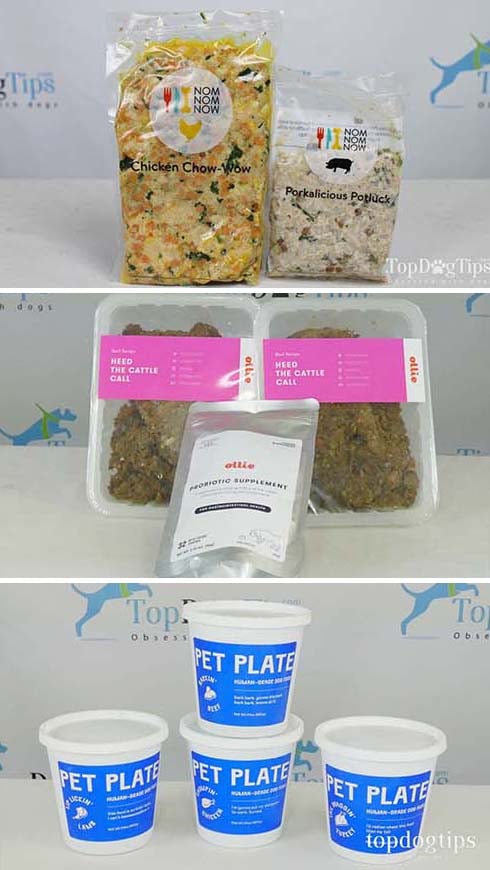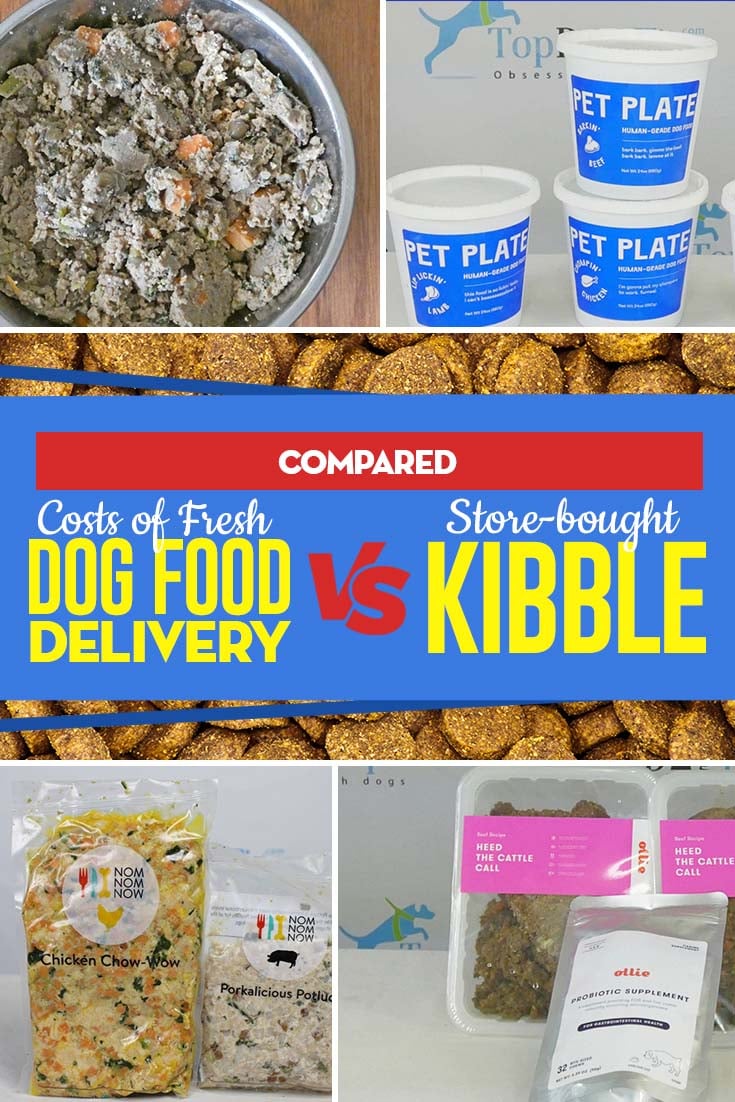
Table of Contents
Food is among the most basic necessities all pet owners must provide for their pups.
And not just any food, mind you. It should be food that's appropriate and good for their health.
But the reality is not all of us have a lot to spend on dog food. And by spend, I mean time and/or money.
With the continuous rise in food prices and commodities and many of us grinding more to earn money, being practical is the way to go.
That said, what type of food are we going to get the most bang for our buck without sacrificing their quality and benefit to our furry friends?
Which is more beneficial, nutrition-wise?
Dr. Lindsey Bullen, a board-certified veterinary nutritionist who works with the Veterinary Specialty Hospital of the Carolinas and has consulted with pet food companies in the past, said that there's no one-size-fits-all of which can provide the best possible nutrition to dogs. “In terms of being nutritionally superior, [fresh pet food diets] are not. It’s just going to depend on what that pet needs and the individual diet that the client has provided for that pet.”
So, if we rule out the nutritional value, which, then, is more cost-effective?
in this article, we will compare the cost of fresh dog food delivery vs. store-bought kibble.
Let's get to it!
Fresh Dog Food Delivery vs. Store-bought Kibble: What are they?
What is a Fresh Dog Food Delivery?
In truth, Dr. Bullen said, the term “fresh food” doesn't have an exact definition.
It's only generally about dog food that's made fresh, with no preservatives whatsoever.
As the name suggests, a fresh dog food delivery is “fresh food” put together by experts that they deliver straight to your doorsteps for your dog's consumption.
Some offer a weekly, bi-weekly, or even monthly delivery.
These are often “human grade” and include fresh ingredients like fruits, vegetables, and quality meats with no preservatives.
A lot of busy pet parents opt for this service not only because it's healthy but you can also customize it based on your dog's breed, age, and nutritional requirements.
Some brands actually hire certified pet nutritionists, who you can consult with upon registration.
That means you are still ‘hands-on' on what your dog eats without spending a lot of time preparing them.
These are also delivered in portion sizes, which means you only have to thaw or heat it before letting your pup munch away.
Talk about convenience, eh?
RELATED: Review: Fresh Dog Food Delivery Services
What are Kibbles?
Kibbles are, perhaps, the most common food for dogs anywhere in the world.
Here, ingredients are mixed, cooked, and processed together before drying and forming into tiny crunchy nibbles.
And while they also have all the necessary nutrients our dogs need, like protein, they still often contain preservatives to prevent them from going rancid.
But what's good here is they're shelf-stable, unlike fresh dog food that's prone to spoilage if not stored properly.
As long as the kibbles are kept in an airtight container and stored in a cool, dry area, you can expect them to last for months.
Costs of Fresh Dog Food Delivery vs. Store-bought Kibble
I don't know about you, but I sure have only a limited budget for my family's food and my dogs' food.
And we know how the prices of different dog foods vary drastically.
There are a lot of factors that drive dog food prices up: the lingering pandemic effect, higher prices of raw materials, and even how millennial parents (raising my hand!) seem to spend more on their pets compared to older generations.
Traditionally, pet parents only have two options to feed their dogs: kibble or making homemade dog food.
But recently, the market has evolved to include dog food delivery services as a new, big competitor to store-bought products.
We have even reviewed several such services to test how they work and what fresh dog food they deliver, including the most popular ones: NomNomNow, Ollie, PetPlate, and The Farmer's Dog.
After tons of journalistic investigations and scientific reports over the past few years that revealed the deplorable quality of many commercial bad dog food brands, more owners are considering switching to a human-grade fresh dog food delivery service.
But the biggest disadvantage of such services is their cost.
Unsurprisingly, fresh dog food is far more expensive than store-bought kibble.
But the question is: is the price worth it?
That's what we're going to take a look at in the following sections.
Cost of Fresh Dog Food Delivery
Below is a list of the seven most popular dog food delivery services in the U.S., their monthly costs, and whatever deals the companies may be running.
But before you look at the chart, there are a few important notes to keep in mind:
1) The monthly price ranges provided in the following chart are approximate costs of each meal delivery service’s monthly cost, based on the price they charge per size category of dogs (small, medium, large breeds).
2) The price range is calculated based on the approximate amount, in pounds, of fresh dog food that each dog weight category requires per month, determined by their size.
3) For the purpose of this chart, the prices reflect the costs of the required amounts of fresh dog food for the following size and weight categories of dogs:
-
- Small Breed Dogs: weighing between 5 to 20 pounds.
- Medium Breed Dogs: weighing between 21 to 60 pounds.
- Large Breed Dogs: weighing between 61 to 100 pounds.
4) You can click on the included links that are provided to visit each fresh dog food delivery company’s website to learn more about the specific ingredients included in the different types of meals they offer, discounts, deals, delivery schedules, shipping costs, and more.
| Company Name | Monthly Price | Offers/Discounts |
| NomNomNow (our review here) |
Small Dog: $136.00 Medium Dog: $230.00 Large Dog: $368.00 |
* 50% off of your first order. * 30-day satisfaction guaranteed trial period. * Free shipping. |
| Spot & Tango | Small Dog: $70.00 Medium Dog: $280.00 Large Dog: $360.00 |
* 50% off of your first order. * Two-week trial period. * Free shipping. |
| Ollie (our review here) |
Small Dog: $84.00 Medium Dog: $240.00 Large Dog: $320.00 |
* 50% off of your first order. * Free shipping. |
| Pet Plate (our review here) |
Small Dog: $120.00 Medium Dog: $260.00 Large Dog: $300.00 |
* 1-week trial box is 75% off. * 35% off of your first order. * Free to reasonable shipping. |
| Grocery Pup | Small Dog: $102.00 Medium Dog: $185.00 Large Dog: $300.00 |
* 10% off of a sampler 3lbs pack. * 20% off of your first order. * $9.99 shipping in the U.S. |
| The Farmer’s Dog (our review here) |
Small Dog: $111.00 Medium Dog: $192.00 Large Dog: $274.00 |
* 20% off of your first order. * Refundable 1st order. * Free shipping. |
| Darwin’s Natural Pet Products | Small Dog: $66.00 Medium Dog: $198.00 Large Dog: $304.00 |
* 10lbs pack of food for $14.95 for first time customers. * Shipping cost included in the price of food, based on weight and location of delivery (free delivery to Portland and Seattle). |
Cost of Store-bought Commercial Dog Food/Kibble
Below is a list of five popular premium quality dog food brands (dry kibble) in the U.S., their price per pound of dog food, and total monthly cost based on dog size.
Before you look at the chart, here are a few notes to keep in mind:
1) The price range per pound of dog food is given due to the fact that the price per pound of each food can vary based on which retailer the food is purchased from.
2) The price range of the total monthly cost that's calculated per size of a dog is based upon the weight of dry food that the three different dog size categories require per month, in general. That information is then translated into the price per pound of each specific type of dog food brand that's included in the chart and what that price per pound equals each month for each of the three size categories of dogs.
3) Here are the amounts of dry dog food that each size category of dogs will generally require per month:
-
- Small Breed Dogs: that weigh between 5 to 25 pounds need approx. 2 to 8 pounds of dry dog food per month.
- Medium Breed Dogs: that weigh between 26 to 50 pounds, need approx. 8 to 16 pounds of dry dog food per month.
- Large Breed Dogs: that weigh between 51 to 100 pounds, need approx. 16 to 24 pounds of dry dog food per month.
4) Use the “price per pound” information provided in the chart to calculate the specific amount of dog food that you know your pooch consumes. Having the overall price range of each type of dry dog food for each breed size category calculated per month allows you to easily and effectively compare the overall prices of a wide variety of store-bought kibbles versus the meal delivery services noted above.
| Brand Name & Formula | Price per lb | Price per month |
| Acana Grain Free Grasslands Formula |
$2.40 – $4.00 | Small Dog: $4.80 – $32.00 Medium Dog: $19.20 – $64.00 Large Dog: $38.40 – $96.00 |
| Canidae Grain Free PURE Formula |
$2.25 – $2.50 | Small Dog: $4.50 – $20.00 Medium Dog: $18.00 – $40.00 Large Dog: $36.00 – $60.00 |
| Castor and Pollux Organix Chicken & Sweet Potato Recipe |
$1.60 – $2.00 | Small Dog: $3.20 – $16.00 Medium Dog: $12.80 – $32.00 Large Dog: $25.60 – $48.00 |
| EVO Herring / Salmon Formula |
$2.27 – $2.52 | Small Dog: $4.54 – $20.16 Medium Dog: $18.16 – $40.32 Large Dog: $36.32 – $60.48 |
| Wellness Complete Health Chicken & Oatmeal Formula |
$1.57 – $1.83 | Small Dog: $3.14 – $14.64 Medium Dog: $12.56 – $29.28 Large Dog: $25.12 – $43.92 |
FAQs about Fresh Dog Food Delivery and Kibbles
What is better for dogs, kibble or fresh food?
Both kibble and fresh food can be appropriate for dogs, depending on their individual needs and preferences.
Kibble is a convenient and cost-effective option that provides complete and balanced nutrition for dogs.
Many kibble brands are formulated to meet the nutritional needs of dogs of different ages, sizes, and activity levels.
However, some dogs may have difficulty digesting kibble or may have specific dietary needs that are not met by commercial kibble brands.
On the other hand, fresh food, such as raw or cooked meat, vegetables, and fruits, can also be a healthy and nutritious option for dogs.
Fresh food can provide a variety of nutrients and flavors that may not be available in commercial kibble and can be especially beneficial for dogs with specific dietary needs or sensitivities.
However, it's important to ensure that fresh food is properly balanced and meets all of the dog's nutritional needs.
Ultimately, the best option for your dog will depend on their individual needs and preferences, as well as your own lifestyle and budget.
It's important to consult with a veterinarian or a professional dog nutritionist to determine the best diet for your dog and to ensure that they are receiving all of the nutrients they need to thrive.
How do you supplement dog kibble with fresh food?
To supplement dog kibble with fresh food, you can add small amounts of fresh food to it, gradually increasing the amount over time.
Fresh food options can include lean meats, vegetables, fruits, and whole grains.
It's important to ensure that the fresh food is properly balanced and meets all of your dog's nutritional needs.
You can consult with a veterinarian or a professional dog nutritionist to determine the best fresh food options and portion sizes for your dog.
Additionally, it's important to introduce new foods gradually and monitor your dog's response to ensure that they do not experience any digestive issues or allergic reactions.
Can you mix fresh dog food with kibble?
Yes, you can mix fresh dog food with kibble to provide your dog with a balanced and varied diet.
Mixing fresh food with kibble can help to provide a variety of nutrients and flavors that may not be available in commercial kibble and can be especially beneficial for dogs with specific dietary needs or sensitivities.
However, it's important to ensure that the fresh food is properly balanced and meets all of your dog's nutritional needs and to introduce new foods gradually to avoid digestive issues or allergic reactions.
You can consult with a veterinarian or a professional dog nutritionist to determine the best fresh food options and portion sizes for your dog.
Fresh Dog Food Delivery vs. Store-Bought Kibble: Before You Go…
Store-bought kibbles are definitely cheaper and more affordable than fresh dog food delivery.
And as Dr. Bullen said, they really aren't far off in terms of nutritional value.
It all boils down to the needs and the biological build of your dog—some can digest kibble better than others, after all.
Ultimately, our advice would be to consult your vet when planning to start or switch your dog's diet that's more in line with your budget.
Or, if you have a limited budget and enough time to prepare, why not go for homemade dog food?
We have a plethora of homemade dog food recipes you can make at home.
Just let us know how it went!
Want to read more about dog food and nutrition? Check out our recommended articles below.
Related Articles:
- The Pros and Cons of Fresh Dog Food
- The Best Dehydrated Dog Food Brands (2022)
- What Human Food Can Dogs Eat?
Want to share this?














